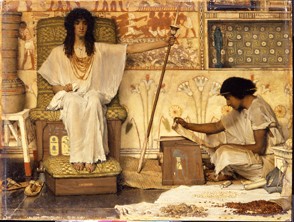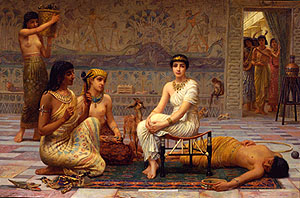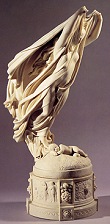Donald Pittenger at 2 Blowhards writes about strategies for museum visits. He and the commenters have that field pretty well covered, so I won't take it up here; but it did set me thinking about the extraneous factors that can add to, or detract from, the value and enjoyment of a museum.
Here is a scorecard of both positive and negative factors that, aside from the exhibits, affect the quality of the experience.
Positive
Crowd control. The single most important variable is how many people you have to share the space with. Have you ever been to one of those "blockbuster" exhibitions where it's like being in Times Square on New Year's Eve? It's not just that you have to squeeze your way through hordes to get near the objects you want to look at, and listen to the yakking of everyone around you; besides that, once you do get into viewing position, you feel a sort of guilt for occupying the space and a self-administered compulsion to move along before you've even had time to connect with what you're looking at.
For very popular exhibitions or museums, there seems no alternative to timed admissions and exiting. And the number of admissions for each slice of the clock should be reasonable, not all that the traffic will bear, or there's no point. It's frustrating if this allows less time than you might ideally want, but by keeping the head count to a manageable number, you can at least look at the exhibits in an ambience that lends itself to appreciation.
Two museums in Rome illustrate the difference in policy. The Vatican Museums pack 'em in disgracefully — it's like trying to look at art in a football crowd. The Galleria Borghese sells tickets for particular times (you can even buy them on the Internet) and its rooms are, as a result, moderately populated and lend themselves to reasonably quiet contemplation. For efficent crowd control, add 10 points.
Dining and refreshments. It's essential to be able to call a halt and pull yourself together during a visit to a big museum. When I am looking at high-quality art, I become subject to the delusion of being a solid citizen, and want to have a serious restaurant available within the precincts. (The French, naturally, are very good at this.) It's equally important for there to be a cafe for light refreshments and a bar, so you can tune up your art-appreciation cranial circuits through a mild indulgence in Omar Khayyam's favorite pastime. For good dining and drinking opportunities, add 5 points.
Seating. Museum Foot Syndrome can strike at any time. First aid, in the form of posterior support, must be ready to, er, hand. There should be a comfortable bench in the center of every room. (Bench, not a seat with a back, so that you can sit facing any direction.) For good seating, add 5 points.Guide map. Sure, every museum gives you a leaflet with a floor plan. But the upmarket version does more than tell you, "Room XVII, European sculpture and furnishings, 1500–1800," etc. It should list the artists and a selection of the works to be found in that space. The Getty in Los Angeles has a guide map that is a model of its kind. It offers a 3D-like view of the various buildings and of the grounds, with callouts from the plan of each floor of each building to a description of the contents as well as photographs of selected artworks. For a good guide map, add 3 points.Descriptive labels. Purists decry any labeling of art objects other than the name of the artist, the title of the piece and the date. This is still the procedure in most art museums in Europe, I think. American museums tend to add descriptions. The anti-description argument is that you should experience the work directly, unfiltered through someone else's concepts. I sympathize with that position, but can't fully agree. It depends on the quality of the description. Descriptive labels should be short — there's rarely any need for more than three paragraphs — and primarily concerned with the item's aesthetic aspects. If the artist is little known, a brief bio can be useful. Sometimes it's worthwhile to include a few words of cultural background, but that should not be an opportunity for the curator to interpret the piece in the light of his or her political and social leanings. For good descriptive labels, add 3 points.Negative
Defacing the exterior. It's become de rigueur to drape the facade of art museums with huge banners touting temporary exhibits. The banners can, admittedly, be colorful and attractive, but they can also detract from the architecture — for better or worse, depending on the architecture. A dignified classical building or an ornate, Beaux Arts front should not be tarted up with what amounts to advertising.
Banners are as nothing, though, compared with the barbarian deconstruction of a stately old building by plopping in front of it a hideous raw-concrete or rusty-wire "sculptural" atrocity of the sort that was all the rage in the 1960s, or some smart-ass, pop-art magnified vacuum cleaner or paper clip in the Claes Oldenburg vein. For ruining an attractive exterior, subtract 5 points.
Defacing the lobby. Hanging a Calder mobile to dominate the lobby is a sure sign of condescending, pseudo-hip pandering to the lowest common denominator. It's there because everybody will recognize it and feel oh-so-clever. If this sounds like a dig at the East Building of Washington's National Gallery, well, if the shoe fits … . For a Calder mobile in the lobby, deduct 25 points.
Calder is now such a standard-issue bore that some enterprising institutions have had to come up with a newer, please-all-comers substitute. Thank goodness for Dale Chihuly! Safe, recognizable, contemporary — whoo-ee! The middlebrow's Thomas Kinkade. For a Chihuly sculpture in the lobby, deduct 10 points.
Free admission for children. Children below a certain age — say, 10 — simply don't belong in certain museums, particularly art galleries. The Frick in New York is the only museum I know of that has a policy of excluding them, or used to (I expect they've been under savage pressure to relent). If so-called art lovers can't bear to be separated from their little darlings for a few hours or are too cheap to hire a baby sitter, sod them. I have spoken. For encouraging young children to attend exhibitions meant for grown-ups, deduct 10 points.
Placing a store at the entrance to the museum. There's nothing wrong with museums having stores and gift shops if it helps with the budget, and some of them are nice places to shop. But please — let's keep things in proportion! A store shouldn't be the first thing you see in a museum. Museums ought to uphold the principle that some things come before commerce. Good on the British Museum, which used to have its gift shop right inside the main doors but moved it to a more suitable location in the recent renovation and re-design. For over-emphasizing retail, deduct 5 points.
Neutral
I'm not much bothered one way or the other about the portable tape-recorded guided tours playing through headphones that are now ubiquitous in art museums. I don't use them because somebody banging on in my ears about what I'm seeing doesn't appeal to me, and they cost money, which doesn't appeal to me either. But some perfectly intelligent people use these devices and like them. A matter of taste.
If you have additional criteria to add to the scorecard, or want to dissent from some of mine, that's what the comment feature is there for.





































